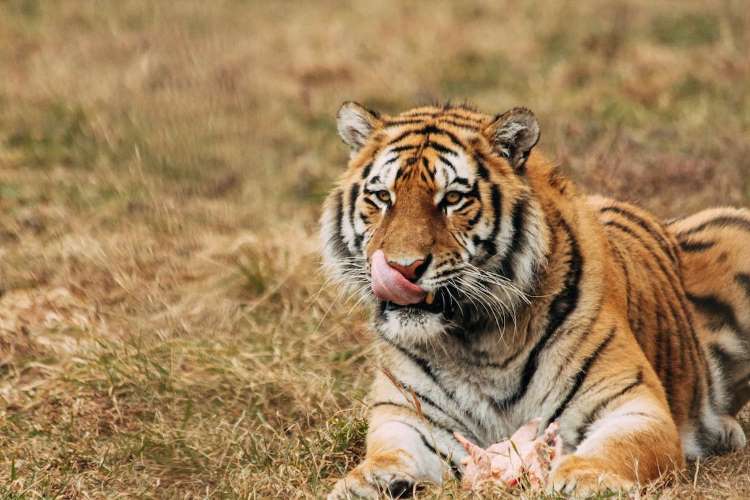
Human-wildlife conflicts: A healthy, equitable future for the human species is dependent on the health and integrity of ecosystems and habitats. Healthy communities rely on well-functioning ecosystems. They provide clean air, fresh water, medicines, and food security. They also limit disease and stabilise the climate. But biodiversity loss is happening at an unprecedented rate, impacting human wellbeing worldwide.
Forests cover 31% of the World’s land surface, approximately 4.06 billion hectares, acting as an important buffer against climate change. Asia is home to some of the richest and most biodiverse forests in the world. However, global forest cover has declined by one million square kilometers since 1960, while cropland and pasture have increased by roughly the same extent. Over 420 million hectares of forest have been lost since 1990. Each minute 2,400 trees are cut down. Nearly 95% of this deforestation occurs in the tropics.
As per India State of Forest Report 2021, the area under ‘very dense’ forest is 87,742 sq km, while ‘moderately dense’ forest has an area of 2,39,564 sq km within the total recorded forest area of 7,38,373 sq km. The proportion of very dense and moderately dense forests within the total forest area of the country is 44.33%.
During the last five years, India diverted over 88,903 hectares of forest land, a size more than the area of Mumbai and Kolkata put together, for non-forestry purpose. Over 19,424 hectares were diverted for road construction, 18,847 hectares for mining, 13,344 hectares for irrigation projects, 9,469 hectares for transmission lines. and 7,630 hectares for defence projects.
READ I Explained: Rising number of human-elephant conflicts in Kerala
Human-wildlife conflicts
Human and wildlife wellbeing are inextricably linked. When humans coexist with and avoid persecuting wildlife in and around communities, it safeguards ecosystem health, agricultural stability, food security, and the creation of new sustainable economies such as ecotourism. Ultimately, coexistence with wildlife is essential for humans, and animals alike.
Every year, hundreds of humans and thousands of animals die due to human-wildlife conflicts. Habitat loss and in some instances conservation successes combined with an ever-increasing human population have resulted in humans and wild animals living in closer proximity and sharing the same scarce resources. The conservation of animals is an important global good, but the reality is that those living in proximity with wildlife usually carry the cost associated with this conservation imperative, including loss of income, essential crops to support their livelihoods and sometimes loss of human life.
Conflict between humans and animals is one of the main threats to the long-term survival of some of the world’s most iconic species. Globally, conflict-related killing affects more than 75% of the world’s wild cat species.
Human-wildlife conflicts in India
India will be most affected by human-wildlife conflict because it had the world’s largest human population as well as large populations of tigers, Asian elephants, one-horned rhinos, Asiatic lions, and other species.
The increase in number of tigers in India is good news, but the rise in tiger population has also shrunk their habitat. As a result, human-wildlife conflicts have increased drastically in every tiger reserve of the country. According to the fifth cycle of the All-India Tiger Estimation (2022) released last week, the number of tigers in India has risen by 200 in the last four years. In contrast, the Western Ghats which holds the world’s largest tiger population recorded a significant decline. The number of tigers here fell from 981 in 2018 to 824 in 2022.
While on one hand the positive numbers are being hailed as the success of Project Tiger, experts and activists are concerned that this could signal an even higher number of human-animal conflict cases. The reasons are simple, tigers are running out of forest cover, prey availability and water, and are venturing into human-populated areas for survival. It was revealed by the forest authorities that in the last 10 years, over 50% of the human fatalities and casualties involve either tigers or leopards.
Conflict with elephants in Kerala
Nearly 30% of Kerala’s geographical area are forests, and the state has a healthy wildlife population with 190 tigers and 5,706 elephants. At the same time, there are several densely populated human settlements and farmlands near protected forests.
According to Kerala Forest Department data (March, 2022), the state has, since 2011, reported 34,875 cases of wildlife attacks, leaving 1,233 dead and 6,803 injured. Over 640 lives were claimed in five years (2018-2023) and 621 cases of crop destruction have been reported. At least 966 complaints have been filed with the forest department. The total loss amounts to over Rs 3 crore. Another RTI query revels 3,310 people have died in India due to attacks by wild elephants in the last 7 years. 105 people have lost their lives in Kerala between 2018 and 2022.
Fragmentation of forests, shrinking habitat and human settlements in elephant corridors are cited as reasons for these losses. Another major factor behind the human-wildlife conflicts is the depletion in the quality of forest habitats in the state is due to the growth of invasive alien plants. Shrinking of their habitat and corridors force these jumbos to stray into human settlements.
Increasing forest encroachment in several parts of the state is becoming a source of concern. Over 30 lakh people are living on the periphery of 23 protected forests spread across 115 densely populated panchayats in Kerala. In the past year, locals have reported a rise in the number of elephants trespassing the fields and main roads, chasing vehicles and raiding shops. There are also cases of monkeys, flying squirrels, and wild boars ravaging crops.
Encroachment of buffer zone
Buffer zone is the area peripheral to the critical tiger or elephant habitat or core area providing supplementary habitat for dispersing tigers/elephants, besides offering scope for co-existence of human activity.
In a landmark judgement, the Supreme Court on June 3, 2022 mandated a minimum of 1 km ecologically sensitive zone, or buffer zone, around all protected forests in the country. If this is strictly enforced, in Kerala alone, around 3.8 lakh acre land would come in the buffer zone, major chunk of it is agricultural land.
At least 2 lakh households, around 4 lakh people, mainly farmers, could be directly affected. Hence states like Kerala strongly objected to this judgment, led by Christian churches and political parties. Supreme Court in January 2023 decided to refer the petitions seeking amendment in the buffer zone judgment to a three-judge bench. The final verdict is still awaited.
The way forward
Completely eradicating human-wildlife conflict is not possible. But well-planned, integrated approaches to managing it can reduce conflicts and lead to a form of coexistence between people and animals.
Recently, the government released 14 guidelines to address human-wildlife conflict which look to facilitate common understanding among key stakeholders on what constitutes effective and efficient mitigation of human-wildlife conflicts in India. The guidelines are advisory in nature and expected to facilitate further development of site-specific human-wildlife conflicts mitigation measures.
Strictly maintaining the buffer zone in between the forest boundary and the human settlement, relocating of human settlements from near forest land, regeneration of vegetation/prey/water within the forest area, and effective electric/solar fencing are some of the practical steps to adopt.
While observing the Earth Day 2023, we need to do more to convince the world of the need to invest more in our planet to improve our environment, minimise the human-animal conflict and give our descendants a better and safer future.
(The author is member of UN Roster of Consultants on Environment & Development.)
George Cheriyan is Director of Centre for Environment and Sustainable Development India, a national NGO in Special Consultative Status with UN-ECOSOC, and accredited with UNEP & UN ESCAP. CESDI is also a member of South Asia Network on SDGs.


